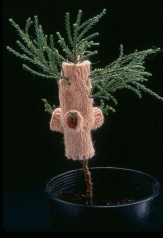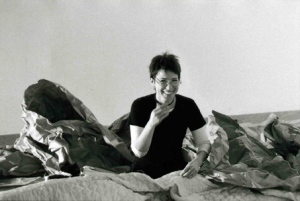My work as a sculptor focuses on the interface between the built and the natural environment. It often involves the concept of a biotope, which is a small environment where human and non-human populations overlap. It may also concern the idea of “trans-species giving,” which asserts that the commonalities between life forms are such that we may actually be able to give other organisms a “hand up,” notwithstanding our own cultural or species-specific assumptions about the natural world. In this vein, I build listening stations for birds that play human music, culture lichen on the sides of skyscrapers in New York City, and design alternative forms of housing for land hermit crabs.
In collaboration with the engineer Dr. Qingze Zou, the biologist Dr. Simeon Kitchoni, and the computer scientist Dr. Ahmed Elgammal, I am currently creating the IndaPlant Project: An Act of Trans-Species Giving. This project entails building light-sensing robotic supports for houseplants that enable them to roam freely in a domestic environment in search of sunlight and water. https://vimeo.com/90457796.
Writing about my art, Richard Klein, Exhibition Director at the Aldrich Museum, states: “Demaray provokes complex questions concerning memory, knowledge, and the collaborative cognitive process that exists between artist and viewer … while making a body of work that has consistently confounded expectations by creating connections between diverse and often contradictory bodies of knowledge.”
I am the recipient of the National Studio Award from the New York Museum of Modern Art/P.S.1 Contemporary Art Center and the New York Foundation for the Arts Fellowship in Sculpture, and was the featured artist at the 2014 Association of Environmental Science Studies symposium, Welcome to the Anthropocene. I live and work in Brooklyn, NY and am an associate professor of fine arts and head of the sculpture concentration at Rutgers University, Camden. On the Rutgers, New Brunswick, campus, I am a work group advisor in the Department of Aerospace and Mechanical Engineering and an advisor at The Art and Artificial Intelligence Laboratory at Rutgers University, in the Department of Computer Science, which is dedicated to supporting artistic practice in the fields of computer vision and machine learning.


I really love your Nuclear Missile project. The multiple dualities throughout the piece is both amusing and pensive. The use of the light blue fabric and big bows contrasts the size and destruction of the nuclear missile so beautifully. Is the baby blue quilting comforting and protecting the missile or suppressing it from a viloent outburst?
hello i am yongmin Kim
it is fantastic.
i am interested in your projects.
i am a kinde of outside adviosry at B-MADE Center(Bio-Medical Arts & Design Education Center) in Korea.
i want to keep in touch with you.
in last, please permit me in friend of FACEBOOK.
thank you.
Hi there,
My pleasure! Would you like to be on my newsletter? I would also like info on B-MADE Center. I may be in Korea in the next year or so and would like to visit!
All my best,
Eliz
Hello Elizabeth, thank you for sharing your wonderful art on your webpages. They are super interesting and very funny as well. Who would have thought of such things but you? I am interested in knowing more about the IndaPlant project. I’m a horticulture student from Niagara College, Canada, who is trying to create a robotic planter for urban balconies and small patios that would roll towards the light to allow plants to gain enough light to satisfy their growing needs. Is it very expensive to build a robot like this?
I would like to try to make one, wondering if it’s possible for you to share your expertise, unless it’s proprietary, of course.
Yes! We are designing kits. Should be fairly easy to put together.
Nice! Eventually we will have kits–so that everybody can make one. Right now, while we are still applying for grants–I’m not allowed to send you the blueprints, however everything you need to build a robotic planter can probably be found at Adafruit. When you finish–send me photos or video. I’d love to post it.
I am a student at NMSU New Mexico in the art 101 class and was wondering if i could get the dimensions of the robotics to use in my art report for class. Thank you for your time
Stacey Glover
Dear Stacy–just seeing your question now! Each floraborg is about 36″ inches in each direction.